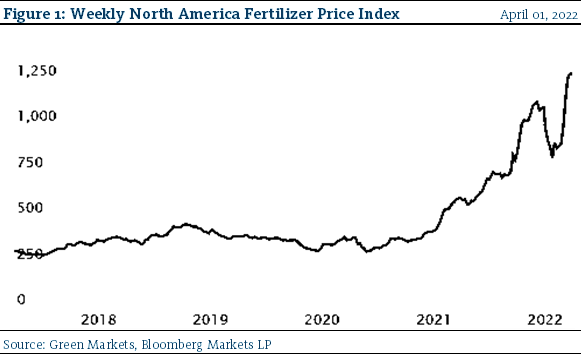Agriculture: Fertilizers and Crops
In this week’s PIO, we continue our series on the Russian-Ukraine crisis on commodities by looking at agriculture. Agriculture is of critical importance to our civilization – the advent of farming led the transition from hunter-gatherers to settlements and agricultural innovations over time freed up a significant percentage of the workforce, driving societal milestones such as the Industrial Revolution. Agriculture is often overlooked as its modest size relative to our global economy (roughly 5% of GDP) belies the importance of feeding the world.
The chart below depicts a blend of North American fertilizer prices. As you can see, fertilizer prices have been on the rise leading to a surge in food prices across the world.
On the input side, there are three main types of fertilizers: nitrogen (an input into ammonia and urea), potassium (an input into potash), and phosphate. The price of nitrogen-based fertilizers has risen dramatically in the year, particularly ammonia which is up over 500% over the last 18 months. Natural gas is the main input used to produce ammonia and the dramatic rise in natural gas prices, particularly in Europe, has been a significant contributor. In addition to supplying much of the natural gas to Europe, Russia is the world’s largest ammonia exporter at approximately 25% of global exports.

Moving to potash, the situation becomes even more dire. Russia and Belarus are the world’s 2nd and 3rd largest exporters and account for 40% of the world’s potash exports. Potash is the most critical fertilizer due to its scarcity and any disruptions from Russia and Ukraine would have a significant impact on global food production. Phosphate is the least discussed fertilizer and our preferred investment in the Resource Fund, partially because it has been overlooked and performed so poorly over the last decade. These low prices have led to production shutdowns and a shortage, particularly in North America where there are only 4 companies that produce phosphate fertilizer. Importing phosphate is becoming increasingly difficult – China (the world’s largest phosphate exporter) and Russia (a significant producer) have banned phosphate exports while Morocco (the 2nd largest exporter) has had import tariffs imposed by the US Department of Commerce.
“This means that” we have a promising outlook for phosphate producers and developers in North America.
National Instrument 31-103 requires registered firms to disclose information that a reasonable investor would expect to know, including any material conflicts with the firm or its representatives. Doug Johnson and/or Pathfinder Asset Management Limited are an insider of companies periodically mentioned in this report. Please visit www.paml.ca for full disclosures.
*All returns are time weighted and net of investment management fees. Returns from the Pathfinder Partners’ Fund and Partners’ Real Return Plus Fund are presented based on the masters series of each fund. The Pathfinder Core: Equity Portfolio and The Pathfinder Core: High Income Portfolio are live accounts. These are actual accounts owned by the Pathfinder Chairman (Equity) and client (High Income) which contain no legacy positions, cash flows or other Pathfinder investment mandates or products. Monthly inception dates for each fund and portfolio are as follows: Pathfinder Core: Equity Portfolio (January 2011), Pathfinder Core: High Income Portfolio (October 2012) Partners’ Fund (April 2011), Partners’ Real Return Plus Fund (April, 2013), and Partners’ Core Plus Fund (November 2014).
Pathfinder Asset Management Limited (PAML) and its affiliates may collectively beneficially own in excess of 10% of one or more classes of the issued and outstanding equity securities mentioned in this newsletter. This publication is intended only to convey information. It is not to be construed as an investment guide or as an offer or solicitation of an offer to buy or sell any of the securities mentioned in it. The author has taken all usual and reasonable precautions to determine that the information contained in this publication has been obtained from sources believed to be reliable and that the procedures used to summarize and analyze such information are based on approved practices and principles in the investment industry. However, the market forces underlying investment value are subject to sudden and dramatic changes and data availability varies from one moment to the next. Consequently, neither the author nor PAML can make any warranty as to the accuracy or completeness of information, analysis or views contained in this publication or their usefulness or suitability in any particular circumstance. You should not undertake any investment or portfolio assessment or other transaction on the basis of this publication, but should first consult your portfolio manager, who can assess all relevant particulars of any proposed investment or transaction. PAML and the author accept no liability of any kind whatsoever or any damages or losses incurred by you as a result of reliance upon or use of this publication.